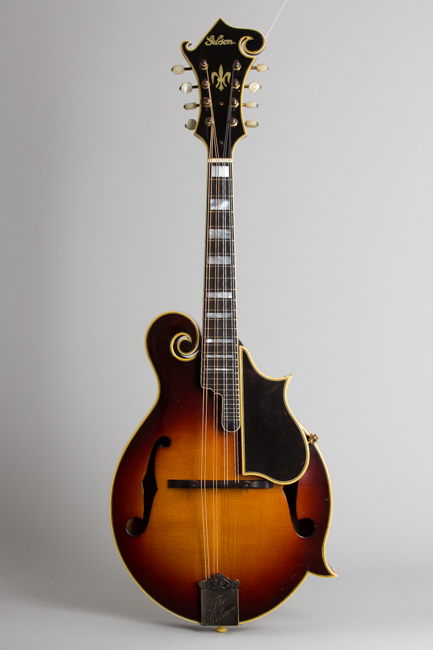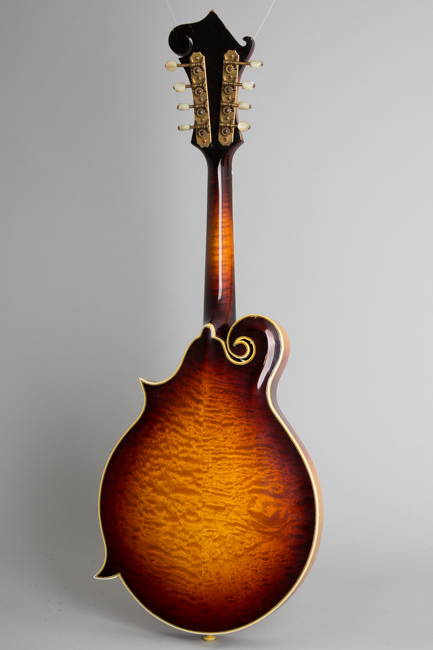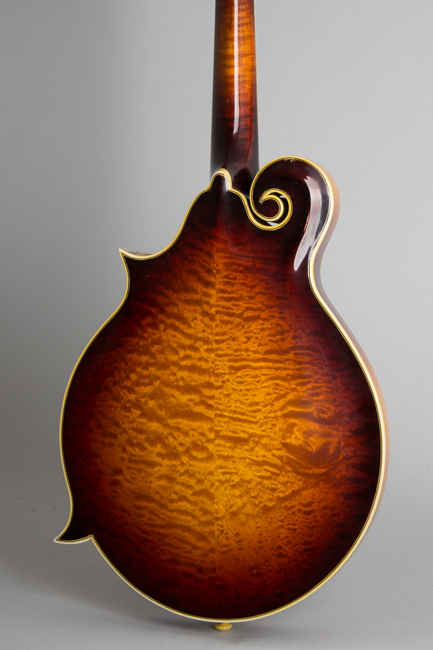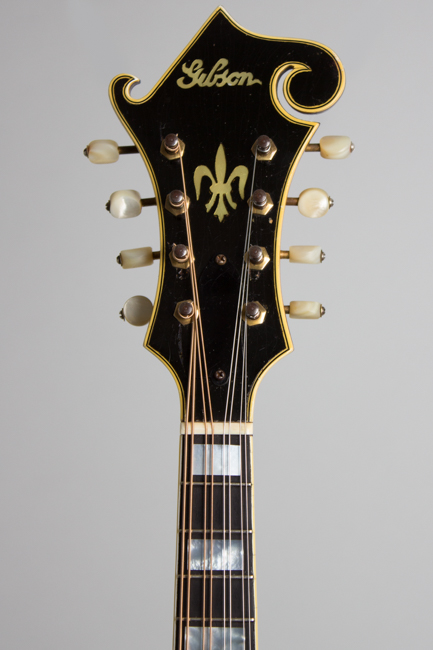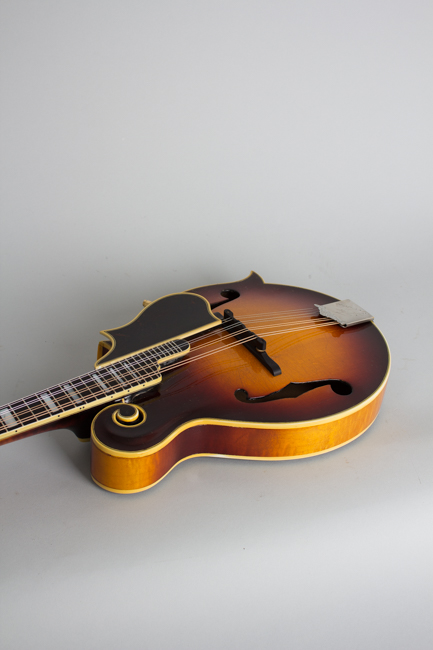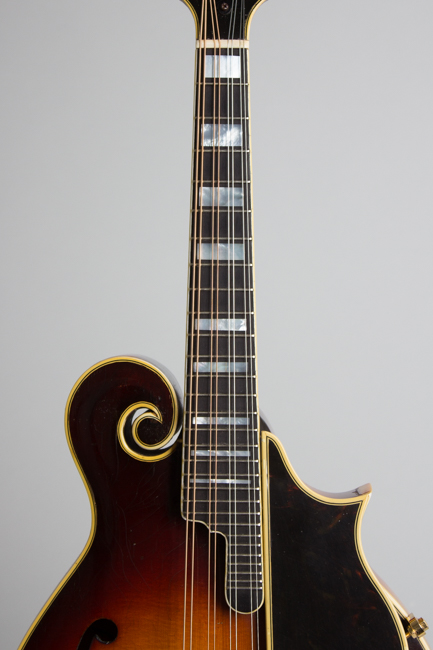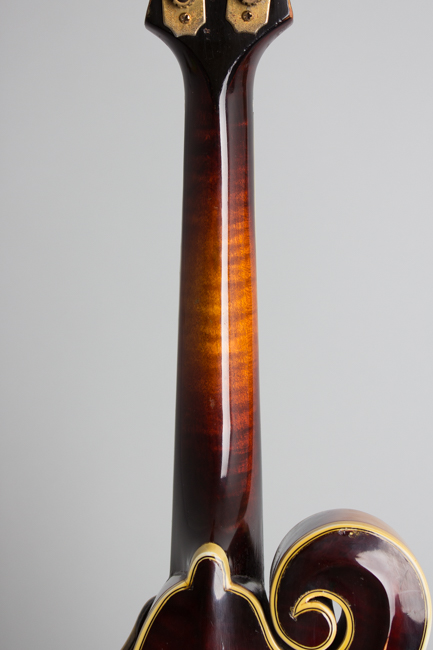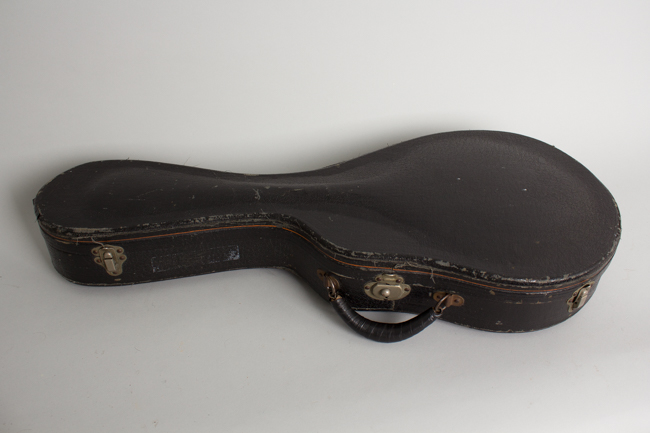Gibson F-5 Carved Top Mandolin (1941)
Summer Sale - PRICE REDUCED!
$35,000.00 + shipping
Buy NowItem # 10812
Prices subject to change without notice.
Gibson F-5 Model Carved Top Mandolin (1941), made in Kalamazoo, Michigan, serial # 97418, sunburst lacquer finish, maple back, sides and neck, spruce top, ebony fingerboard, original black hard shell case.
This is a generally nicely preserved example of a very late pre-War F-5, Gibson's perennial top-of-the-line mandolin. This rarely-seen instrument was built in 1941 and shipped out in 1942 at the height of the swing era. At this point interest in mandolins was at low ebb and looming wartime supply issues caused Gibson to curtail most instrument production.
30 years earlier Gibson was a mandolin company that also made guitars; by this date guitars were all the rage with mandolins only sold in very small numbers. All Gibson mandolins from this period are rare, but the very expensive ($250 plus case) F-5s were built in miniscule numbers. Available production totals indicate 12 shipped out of Kalamazoo in 1941, with a further 17 in 1942 and the last 6 stragglers in 1943. This instrument is marked as #1 of a batch with factory order number 5220, built in mid-late 1941. Most if not all F-5's shipped in 1942-3 appear to belong to this same batch, which was probably the factory's last pre-war run of the model.
The original F-5 was Lloyd Loar's baby in 1922-25, the flagship of the Gibson "Master Model" line and the most expensive and innovative mandolin in the world. Loar and the Gibson team's re-design of Gibson's earlier instruments essentially invented the modern mandolin, including now taken for granted features like the adjustable bridge and truss rod neck.
These instruments were designed for classical and ensemble playing; Bill Monroe would not use one to invent bluegrass until the 1940s. After Loar's departure, the F-5 took a back seat to banjos and then guitars. By the time the Depression hit very few people were interested in plunking down $250 for a mandolin, and it stayed that way until Monroe's playing caused new interest on the model in the '50s.
This 1941 F-5 has many detail differences from the Loar-era models, but is similar in most major respects. The asymmetrical body with upper scroll and two points on treble side has a carved spruce top with violin-style f-holes. It is triple-bound top and back with a rich sunburst finish on all surfaces and a stunning flame figure on the maple back. The single-piece flame maple neck has an ebony fretboard with side stripe binding, pearl block inlays from the first fret, and treble side extension with a total of 29 frets raised above the body.
The triple-bound headstock has a pearl Fleur-de-lys inlay in place of the traditional F-5 "flower pot". This was used previously on the lower priced F-7 model, after they were discontinued it migrated to these late F-5s. The large pre-war "Gibson" script logo is inlaid above it on the peghead. The gold-plated Kluson openback tuners have pearl buttons, another F-5 trademark.
While many consider the 1940s to not be the greatest era for Gibson mandolins this is a very fine-sounding instrument, with plenty of volume, tonal clarity without losing depth and a great "chop." "Loars" are the traditional bluegrass standard, but Sam Bush and Barry Mitterhoff are two virtuoso players who have performed for decades on F-5s from this late pre-war period and this is definitely a world-class mandolin worthy of a master.
Overall length is 27 9/16 in. (70 cm.), 10 1/16 in. (25.6 cm.) wide at lower bout, and 1 11/16 in. (4.3 cm.) in depth, measured at side of rim. Scale length is 14 in. (356 mm.). Width of nut is 1 1/8 in. (29 mm.).
This mandolin is in generally well-preserved original condition, showing some repair and maintenance over the decades but not a lot of actual play wear. Overall it is one of the nicer period F-5's we have ever seen. There finish shows some typical checking, but only small dings, dents and a few pick marks. The area around the bridge has some minor scarring as is typical. The headstock face shows some minor chipping, the edge of the binding piece at the apex of the body point by the cutaway has some finish chipping.
As with many Gibson mandolins from this period, the neck on this F-5 was almost certainly originally underset from the factory, and the instrument's state of preservation may be at least partially attributable to the fact that as built it simply did not play that well! To rectify this it has had a very well done neck re-set, which is a complex procedure on an F-5 and the results are excellent. This of course means some overfinish was done to the neck and heel area, but it is very finely blended and really only visible under blacklight inspection. The binding was replaced on the bass side of the fingerboard only, again a superbly neat job.
In addition to the corrected neck angle, the original small frets have been crowned a bit but still retain good height. The nut is newer. The area of the top just above the center seam has a sealed grain split, running from under the tailpiece to just south of the bridge. Another very small grain split runs up from the lower ball of the bass side F-hole. These have been repaired solidly but visibly, with only minimal finish touchup.
The adjustable bridge is a very fine repro bridge in the original style, down to the small-gauge adjustment wheels. The tailpiece is probably not original to this mandolin but is all vintage Gibson parts, the base appearing to be a silver plated F-5 piece from the 1920's and the cover the standard nickel unit from the same period. Oddly enough the mounting screws and celluloid endpin are original to this exact period, so it is possible the tailpiece is pieces scrounged from around the Gibson factory in 1942. The bound tortoise celluloid pickguard appears original but the gold-plated mounting bracket is a correct newer repro.
The mandolin now plays the way it was intended to, with a moderately low action and room to go higher or lower as desired. The sound is crisp and quite powerful, and we expect it will deepen and mature even more if given some serious play time, something this instrument does not appear to have seen too much of since the last Roosevelt administration! The original shaped case is included, with some external wear but quite solid. Overall this is a wonderful package of pre-war Gibson 8-string goodness, a rare gem indeed. Overall Excellent Condition.
This is a generally nicely preserved example of a very late pre-War F-5, Gibson's perennial top-of-the-line mandolin. This rarely-seen instrument was built in 1941 and shipped out in 1942 at the height of the swing era. At this point interest in mandolins was at low ebb and looming wartime supply issues caused Gibson to curtail most instrument production.
30 years earlier Gibson was a mandolin company that also made guitars; by this date guitars were all the rage with mandolins only sold in very small numbers. All Gibson mandolins from this period are rare, but the very expensive ($250 plus case) F-5s were built in miniscule numbers. Available production totals indicate 12 shipped out of Kalamazoo in 1941, with a further 17 in 1942 and the last 6 stragglers in 1943. This instrument is marked as #1 of a batch with factory order number 5220, built in mid-late 1941. Most if not all F-5's shipped in 1942-3 appear to belong to this same batch, which was probably the factory's last pre-war run of the model.
The original F-5 was Lloyd Loar's baby in 1922-25, the flagship of the Gibson "Master Model" line and the most expensive and innovative mandolin in the world. Loar and the Gibson team's re-design of Gibson's earlier instruments essentially invented the modern mandolin, including now taken for granted features like the adjustable bridge and truss rod neck.
These instruments were designed for classical and ensemble playing; Bill Monroe would not use one to invent bluegrass until the 1940s. After Loar's departure, the F-5 took a back seat to banjos and then guitars. By the time the Depression hit very few people were interested in plunking down $250 for a mandolin, and it stayed that way until Monroe's playing caused new interest on the model in the '50s.
This 1941 F-5 has many detail differences from the Loar-era models, but is similar in most major respects. The asymmetrical body with upper scroll and two points on treble side has a carved spruce top with violin-style f-holes. It is triple-bound top and back with a rich sunburst finish on all surfaces and a stunning flame figure on the maple back. The single-piece flame maple neck has an ebony fretboard with side stripe binding, pearl block inlays from the first fret, and treble side extension with a total of 29 frets raised above the body.
The triple-bound headstock has a pearl Fleur-de-lys inlay in place of the traditional F-5 "flower pot". This was used previously on the lower priced F-7 model, after they were discontinued it migrated to these late F-5s. The large pre-war "Gibson" script logo is inlaid above it on the peghead. The gold-plated Kluson openback tuners have pearl buttons, another F-5 trademark.
While many consider the 1940s to not be the greatest era for Gibson mandolins this is a very fine-sounding instrument, with plenty of volume, tonal clarity without losing depth and a great "chop." "Loars" are the traditional bluegrass standard, but Sam Bush and Barry Mitterhoff are two virtuoso players who have performed for decades on F-5s from this late pre-war period and this is definitely a world-class mandolin worthy of a master.
Overall length is 27 9/16 in. (70 cm.), 10 1/16 in. (25.6 cm.) wide at lower bout, and 1 11/16 in. (4.3 cm.) in depth, measured at side of rim. Scale length is 14 in. (356 mm.). Width of nut is 1 1/8 in. (29 mm.).
This mandolin is in generally well-preserved original condition, showing some repair and maintenance over the decades but not a lot of actual play wear. Overall it is one of the nicer period F-5's we have ever seen. There finish shows some typical checking, but only small dings, dents and a few pick marks. The area around the bridge has some minor scarring as is typical. The headstock face shows some minor chipping, the edge of the binding piece at the apex of the body point by the cutaway has some finish chipping.
As with many Gibson mandolins from this period, the neck on this F-5 was almost certainly originally underset from the factory, and the instrument's state of preservation may be at least partially attributable to the fact that as built it simply did not play that well! To rectify this it has had a very well done neck re-set, which is a complex procedure on an F-5 and the results are excellent. This of course means some overfinish was done to the neck and heel area, but it is very finely blended and really only visible under blacklight inspection. The binding was replaced on the bass side of the fingerboard only, again a superbly neat job.
In addition to the corrected neck angle, the original small frets have been crowned a bit but still retain good height. The nut is newer. The area of the top just above the center seam has a sealed grain split, running from under the tailpiece to just south of the bridge. Another very small grain split runs up from the lower ball of the bass side F-hole. These have been repaired solidly but visibly, with only minimal finish touchup.
The adjustable bridge is a very fine repro bridge in the original style, down to the small-gauge adjustment wheels. The tailpiece is probably not original to this mandolin but is all vintage Gibson parts, the base appearing to be a silver plated F-5 piece from the 1920's and the cover the standard nickel unit from the same period. Oddly enough the mounting screws and celluloid endpin are original to this exact period, so it is possible the tailpiece is pieces scrounged from around the Gibson factory in 1942. The bound tortoise celluloid pickguard appears original but the gold-plated mounting bracket is a correct newer repro.
The mandolin now plays the way it was intended to, with a moderately low action and room to go higher or lower as desired. The sound is crisp and quite powerful, and we expect it will deepen and mature even more if given some serious play time, something this instrument does not appear to have seen too much of since the last Roosevelt administration! The original shaped case is included, with some external wear but quite solid. Overall this is a wonderful package of pre-war Gibson 8-string goodness, a rare gem indeed. Overall Excellent Condition.
